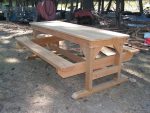In times of crisis, having a reliable food source is crucial for keeping your family fed. Growing your own food can provide peace of mind, even if you don’t have a large garden or outdoor space.
Whether you’re dealing with a small backyard, balcony, or windowsill, these 25 survival foods are easy to grow in limited areas. Let’s dive into some options that could help sustain you and your family during an emergency.
Tomatoes
Tomatoes are a versatile and nutritious option that can thrive in containers or hanging baskets. Cherry and bush varieties are especially great for small spaces, as they don’t take up much room and produce a good amount of fruit. You can grow them indoors or outdoors with proper sunlight and watering.
Not only are tomatoes packed with vitamins, but they also make a great addition to meals. Use them fresh, in sauces, or dehydrate them for long-term storage. This makes them an essential survival crop for any family.
Herbs (Basil, Parsley, Oregano, etc.)
Herbs are a must for enhancing the flavor of your meals, and they grow well in small pots or even window boxes. Whether it’s basil, parsley, oregano, or thyme, these little plants don’t need much room to flourish, making them perfect for tiny spaces.
Besides adding flavor, herbs often have medicinal properties. Many, like basil and oregano, have antioxidants and anti-inflammatory benefits, making them useful in survival situations where resources are limited. Many of these herbs like basil or rosemary can be dehydrated which will extend the shelf life.
Carrots
Carrots are a root vegetable that doesn’t require much space to grow. You can plant them in deep containers, and they’ll grow well as long as they get enough sunlight. Baby carrot varieties are especially suited for small spaces.
Carrots are packed with essential nutrients like beta-carotene, which is important for maintaining good eyesight. They can be eaten fresh, stored in cool conditions, or preserved through canning, making them a handy survival crop.
Peppers
Peppers come in many varieties, from sweet bell peppers to spicy chili peppers, and they all grow well in pots. Just like tomatoes, they love the sun and can be grown indoors or outdoors. Compact pepper plants can produce a surprisingly large harvest in small spaces.
Peppers add flavor and spice to your meals and are rich in vitamins A and C, which are important for your immune system. They can be eaten fresh, dried, or pickled, giving you a versatile option for survival food.
Lettuce
Lettuce is one of the easiest greens to grow in small spaces. It doesn’t need deep soil, so you can plant it in shallow containers or even use a vertical garden setup. Since it grows quickly, you can enjoy fresh lettuce in just a few weeks and lettuce can be dehydrated for longer storage.
Lettuce is great for providing a fresh, crisp texture to meals and is a good source of vitamins and minerals. You can plant different varieties like romaine, butterhead, or leaf lettuce to keep your salads interesting.
Spinach
Spinach is another leafy green that’s perfect for small spaces. It grows quickly and doesn’t need much sunlight, making it ideal for indoor gardening. You can grow it in containers or raised beds and harvest it continually by picking the outer leaves.
Spinach is rich in iron and other essential nutrients that are important for your health. It’s also versatile in the kitchen, whether used in salads, soups, or smoothies, making it a valuable crop during survival situations.
Radishes
Radishes are a fast-growing vegetable that you can harvest in just a few weeks. They don’t require much space, making them ideal for small gardens or containers. The plants also don’t need deep soil, so they’re perfect for shallow beds.
Radishes are high in antioxidants and help with digestion. They can be eaten fresh in salads or cooked as a side dish. Their quick growing time makes them a great option for fast, reliable food during emergencies.
Green Onions
Green onions (or scallions) are easy to grow and can even regrow from scraps. Simply plant them in a small pot or a windowsill garden, and they’ll continue to produce fresh stalks over time.
These onions add flavor to meals and can be eaten raw or cooked. Their ability to regrow quickly from the base makes them a sustainable crop to have on hand during tough times. You can also dehydrate green onions and create a powder base that can be used in your recipes.
Garlic
Garlic is a survival staple due to its long shelf life and medicinal properties. You can grow garlic in containers, and it doesn’t require much space. Simply plant individual cloves, and they’ll sprout into full heads over time.
Garlic not only flavors food but also has immune-boosting properties, making it essential for any survival garden. It’s easy to store for months after harvesting, either fresh or dried.
Cucumbers
Cucumbers are great for growing vertically, which makes them perfect for small spaces. Train them to climb up a trellis or netting, and they’ll produce plenty of fruit without taking up much ground area.
Cucumbers are refreshing and hydrating, which is helpful in stressful situations. They’re also easy to preserve by pickling, providing a long-lasting food option during emergencies.
Zucchini
Zucchini is another crop that can be grown vertically, making it a good choice for limited spaces. You can train the plants to grow up a support system, allowing you to maximize your harvest.
Zucchini is a highly productive plant, meaning you’ll get a lot of food for a small amount of effort. It’s versatile in cooking, whether used in soups, stir-fries, or baked goods, making it a survival garden favorite.
Potatoes
Potatoes are known for their ability to grow in tight spaces, such as potato bags or buckets. You can even stack layers of soil as they grow, maximizing the yield in a small footprint.
Potatoes are rich in carbohydrates, making them a good energy source in survival situations. They store well and can be used in a variety of dishes, making them a reliable food to grow in emergencies.
Strawberries
Strawberries can be grown in hanging baskets or vertical planters, making them a perfect fit for small spaces. They don’t need much soil to produce sweet, juicy berries.
Not only are strawberries a delicious treat, but they’re also packed with vitamins and antioxidants. You can eat them fresh, preserve them as jam, or freeze them for later, providing a sweet survival food option.
Kale
Kale is one of the hardiest greens, and it grows well in containers or raised beds. It can tolerate cooler temperatures, which makes it a reliable crop year-round in some regions.
Rich in vitamins A, C, and K, kale provides essential nutrients for keeping your family healthy. It’s also incredibly versatile, as it can be used in salads, smoothies, or cooked dishes.
Bush Beans
Bush beans are compact and easy to grow in small containers or garden beds. Unlike pole beans, they don’t need a trellis, making them ideal for tight spaces.
Bush beans are rich in protein and fiber, making them a valuable crop in survival situations. You can eat them fresh or preserve them through canning or drying for long-term storage.
Beets
Beets can be grown in deep containers and don’t take up much room. They’re a dual-purpose plant, as you can eat both the root and the greens.
Beets are full of essential nutrients like iron and folate, which are important for overall health. They can be eaten fresh, pickled, or stored for later, making them a great addition to any survival garden.
Swiss Chard
Swiss chard is a leafy green that grows well in small spaces. It’s easy to grow in containers and can be harvested multiple times by cutting the outer leaves.
This nutritious green is packed with vitamins and minerals, making it a healthy choice for your survival garden. It’s versatile in the kitchen and can be used in everything from salads to sautés.
Broccoli
Broccoli is a nutrient-dense vegetable that can grow well in containers or raised beds. Compact varieties are perfect for small gardens and don’t require a lot of space.
Broccoli is rich in vitamins and antioxidants, which are important for maintaining health during tough times. It can be eaten fresh or frozen for later use, making it a versatile survival food.
Peas
Peas are another crop that grows well in small spaces. You can grow them vertically using a trellis, which makes them perfect for limited garden areas.
Peas are rich in protein and fiber, making them a nutritious addition to your diet. They can be eaten fresh or preserved by freezing, ensuring you have a reliable food source during emergencies.
Cabbage
Cabbage is a compact vegetable that grows well in small spaces. You can plant it in containers or raised beds, and it produces large heads that store well.
Cabbage is rich in vitamin C and fiber, and it can be used in a variety of dishes. It’s also a great candidate for fermenting, which turns it into sauerkraut—a long-lasting, nutrient-dense food.
Turnips
Turnips are another root vegetable that doesn’t require much room to grow. You can plant them in deep containers or raised beds, and they’ll thrive with minimal care.
Turnips provide both edible roots and greens, making them a dual-purpose crop. They’re packed with nutrients and can be stored for long periods, either fresh or preserved, which makes them a great survival food.
Lemons
Lemons can be grown in small pots indoors or on balconies, provided they get enough sunlight. Dwarf varieties are especially suited for limited spaces, and they’ll produce fruit year-round.
Lemons are rich in vitamin C, which is essential for boosting your immune system. They can be used in everything from drinks to preserving other foods, making them a valuable addition to your survival garden.
Eggplant
Eggplant grows well in containers and is a productive crop, even in small spaces. It requires plenty of sunlight, but once established, it produces a steady supply of fruit.
Eggplant is a versatile vegetable that can be used in a variety of dishes, from stews to casseroles. It’s a healthy, low-calorie food that can help keep your family well-fed in emergencies.
Blueberries
Blueberries are a great option for small spaces, as they can be grown in pots or containers. Dwarf varieties are perfect for patios, balconies, or small gardens. They require acidic soil, but once established, they produce a plentiful harvest of sweet, nutrient-rich berries.
Blueberries are packed with antioxidants and vitamins, making them a healthy addition to your survival food stock. You can enjoy them fresh, freeze them for long-term storage, or use them in jams and desserts, providing a tasty and nutritious option for your family in any emergency.
Mint
Mint is an easy herb to grow and can thrive in small pots or containers. It grows quickly and spreads, so it’s best to keep it confined in its own pot.
Mint adds flavor to meals and can be used for medicinal purposes, like soothing an upset stomach. Its ability to grow rapidly means you’ll always have fresh mint on hand during tough times.
Even if you’re limited on space, there are plenty of survival foods you can grow to help sustain your family during emergencies. From leafy greens to hearty root vegetables, these 25 options can thrive in small areas like containers, balconies, or windowsills. With a bit of planning, you can ensure your family has access to fresh, nutritious food when it’s needed most.
20 Overlooked Survival Foods That Can Save Your Life
While food storage is important for being prepared, there are other ways to bring more security to your family that are lesser known. These often over-looked survival foods may not be for long-term storage but still have a lot of benefits.
101 Canning Recipes for Food Storage
If you are working on your food storage and need some unique ideas – here they are! Over 100 canning recipes broken down by category so you can create a food storage closet for every meal!




